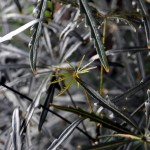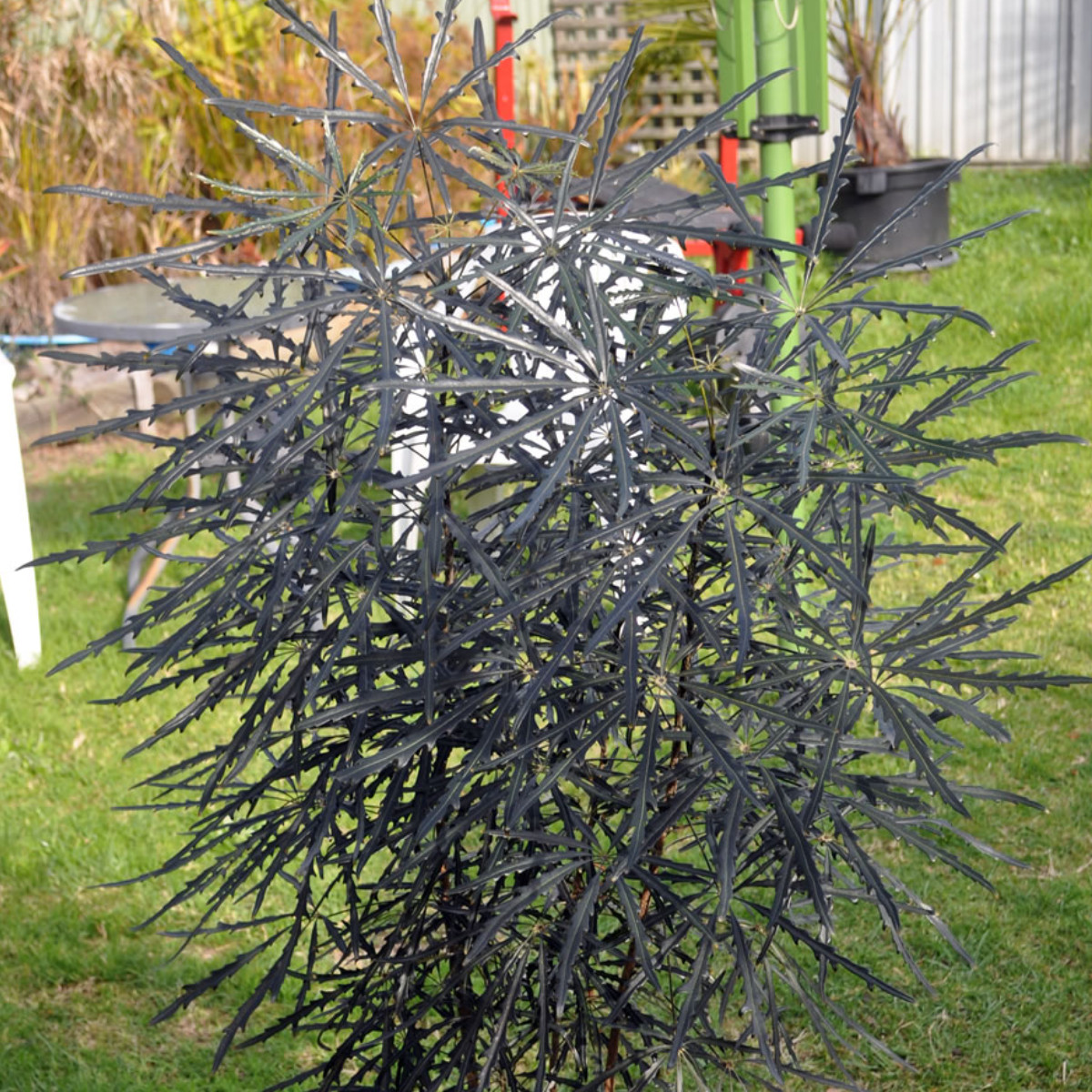Family: Araliaceae
Synonymous: Dizygotheca elegantissima
Dizygotheca laciniata
Aralia elegantissima
Distribution and habbitat: Schefflera elegantissima is a species of flowering plant in the Araliaceae family, native to New Caledonia. Growing to 815m (2649 feet) tall by 2m (7 feet) broad, it is an evergreen shrub or tree. Its leaves are thin, coppery red to dark green with toothed edges. On adult plants the leaves are much broader. In autumn it bears clusters of pale green flowers followed by black fruit.
Description:Schefflera elegantissima when is grown as a houseplant rarely exceed about 2m (7 feet) in height with a spread of about 50cm (20 inch). Schefflera elegantissima is a very slender plant. Its leaves comprise 7 to 10 narrow, leathery leaflets, each 8-10cm (3-4 inch) long and 1cm (0.4 inch) wide, with toothed, undulate edges. The leaflets are arranged in roughly circular form at the tip of slender leaf-stalk. Leaf colour is coppery red at first, but changes to very deep green - in fact almost black. The central stem and leaf-stalks are mottled with creamy white.
Houseplant care: These plants do not normally branch but tend to grow strait up. For a bushy effect, plant two or three small specimens in one pot.
Light: Schefflera elegantissima like bright light but should not be placed where exposed to strong direct sunlight.
Temperature: Warmth and humidity are essential (minimum temperature even during the rest period should be above 15C (59F). Stand the pots on trays or saucers of moist pebbles to increase the humidity.
Water: Water Schefflera elegantissima sparingly at all times, allowing the top two-thirds or so of the potting mixture to dry out before watering again.
Fertiliser: Apply standard liquid fertiliser every two weeks during the active growth period.
Potting and repotting: Use a soil-based potting mixture. Schefflera elegantissima are slow growing and should be moved into one size larger only once in two years. This is best done in early spring. Do not use pots that are needless big. Once plants have reached maximum convenient pot size (probably 20-25cm (8-10 inch)), top-dress them with about 2cm (0.8 inch) or so of fresh mixture every spring.
Gardening: When grown outdoors within its hardiness zones, this somewhat branched, small evergreen tree will tolerate bright light, performing best in light shade. Schefflera elegantissima needs fertile, well-drained soil and protection from strong winds to develop into a nice specimen.
Propagation: New plants can be raised from seed - a method that may sometimes succeed in well heated rooms (with fresh seed sown in spring). But young plants raised professionally are freely available and this is the normal way to acquire a new Schefflera elegantissima and probably more advisable for the amateur gardener.
Alternatively, Schefflera elegantissima can be propagated by air-layering or cuttings.
Problems: When growing Schefflera elegantissima, problems are most likely to appear from incorrect treatment. Otherwise, Schefflera elegantissima has long-term health and usually it is not affected by pests.
Falling lower leaves are probably due to insufficient light and or dry air.
Ungainly growth can be improved by cutting back the stem in early spring to encourage new growth.
Nematodes are a problem in the soil for Schefflera elegantissima.
Treatment: Nematodes should not occur if sterilised pot and potting mixture are used. Chemicals that control these pests are not recommended for indoor kept plants as they are dangerous to people. Destroy infested plants and dispose of potting mixture. Sterilise pots. Avoid all contact between these materials and healthy plants. Do not take cuttings from an infested plant before destroying it. Upper parts can be used.
Alternatively, hot water is used to 'clean' roots of root knot nematode. Plants are immersed in water maintained at precisely 46C (115F) for 16 - 20 minutes, long enough to cook the nematodes but not the plant. After that use sterilised pot and potting mixture.
Mites and scale can be serious leaf problems for Schefflera elegantissima.
Treatment: For mites use an adequate spray pesticide following the instructions on the label.
For scale control examine every crevice for scale and wipe them off with a damp cloth or a fairly stiff brush dipped in soapy water or an appropriate pesticide solution. Then apply the pesticide to the whole plant.
Uses: Schefflera elegantissima can be used as container or above-ground planter near a deck or patio; it is suitable for growing indoors as accent plant.
Schefflera elegantissima provides a tropical look as a house plant indoors or in outdoor settings, whether in containers or at entrance ways where its distinctive foliage casts interesting shadows on background walls. It can be pruned to develop into a small tree. Due to its upright vertical habit,Schefflera elegantissima is best used as an accent or specimen plant.
Schefflera elegantissima can be used to form contrasting displays by associating it with the bold leaves of begonias, codiaeums, aglaonemas and tradescantias.
SUMMARY:
CHARACTERISTICS:
Foliage coloured
Shape upright
Height: 2m (7 feet)
PROPER CARE:
Watering in rest period sparingly
Watering in active growth period sparingly
Light bright
Temperature in rest period min 16C max 24C (61-75F)
Temperature in active growth period min 18C max 27C (64-81F)
Humidity high
Hardiness zones: 10b-11




